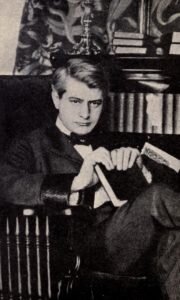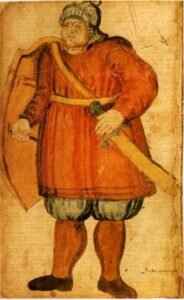Recently I was reading through American Fantastic Tales, edited by Peter Straub and came across a story called ‘Grettir at Thorhall-stead’. At first I didn’t think much of it, it read sort of like a pulp version of a viking saga. But then, BOOM, vampire! This is a story about a flippin’ viking fighting a mother flippin’ vampire! After finishing the story I had to read more about Grettir. In reading the source material I never thought I would come across such modern and complex ideas in something written in the 14th century.
The Story
The short story is about a wandering viking who arrives at a homestead somewhere in Iceland. The homestead is plagued by an un-dead figure who, while living, was hired as a shepherd. This vampire kills each new person hired on and terrorizes the women. That is until Grettir shows up.Grettir sees this vampire as challenge. He stays the night expecting to be woke around midnight by the creature, but instead sleeps the night through only to find this horse killed in the stable in a fairly gruesome fashion. Thorhall, the man in charge of the stead, offers one of his own horses for Grettir to ride away and not be killed, but Grettir refuses.On another night they battle, the two of them doing much damage to one of the buildings, and Grettir finally defeats Glamr the vampire before riding away victorious and with a story to tell.What is really great about this story is that it fits a structure that seems to have existed since the beginning of story. There is an evil, or monster, terrorizing a village/home. A mysterious stranger shows up and defeats the evil/monster. The mysterious stranger then rides away into the sunset. This format fits everything from Beowulf to Shane to A Fist Full of Dollars.
The Author
 This adaptation of a part of the Grettir Saga, about a man named Grettir the Strong, was written by Frank Norris. It was published in 1903. Frank Norris was born in 1870 and was a field reporter who would travel to locations around the world. He studied painting in France and at Berkley. He died in his 30s in 1902. He is mostly known as a part of the American naturalist literary movement, along with Jack London and Stephen Crane.
This adaptation of a part of the Grettir Saga, about a man named Grettir the Strong, was written by Frank Norris. It was published in 1903. Frank Norris was born in 1870 and was a field reporter who would travel to locations around the world. He studied painting in France and at Berkley. He died in his 30s in 1902. He is mostly known as a part of the American naturalist literary movement, along with Jack London and Stephen Crane.
The Original Saga
 The source material covers so much more of Grettir’s life than just his encounter at Thorhall-stead. Grettir isn’t even introduced until chapter 14, and then it spends a few chapters on how ornery he was as a child (and, for some odd reason, I pictured Grettir as Gobber from How to Train Your Dragon; Craig Fergon’s voice and all).It than covers Grettir’s life as a wandering outlaw, including him getting in different scuffles with different families, all wanting vengeance on him for one reason or another. Finally he is caught and defeated by Thorbjorn, but only because Grettir was already wounded through sorcery.
The source material covers so much more of Grettir’s life than just his encounter at Thorhall-stead. Grettir isn’t even introduced until chapter 14, and then it spends a few chapters on how ornery he was as a child (and, for some odd reason, I pictured Grettir as Gobber from How to Train Your Dragon; Craig Fergon’s voice and all).It than covers Grettir’s life as a wandering outlaw, including him getting in different scuffles with different families, all wanting vengeance on him for one reason or another. Finally he is caught and defeated by Thorbjorn, but only because Grettir was already wounded through sorcery.
Humanity and Complexity
What made this Saga an interesting read was how modern it felt. Yes, it had longish sections recounting lists of family relations and place names, but it is easy to infer from everything else that this was a story told for entertainment. Not once, but twice feuds are sparked by arguments over washed up whale carcasses. A dude gets bludgeoned to death with a flippin whale bone! That’s entertainment!
Weregilds
I also found the heavy significance placed on justice interesting. It seems that, without the presence of well respected kings and leadership acting as judges in squabbles between feuding families, the whole of medieval Scandinavia would have been a constant blood bath. Someone would get murdered, then the brother of the victim would kill the murderer (or someone in their family), and on and on. But instead, when matters were brought in for judgement, the leadership would impose a weregild, or ‘man price’. Pretty much the king would demand that the victim’s family would be paid a specified amount by the perpetrator and their family in recompense for the life taken. What’s crazy, is this seemed to work (most of the time) and there would be no further bloodshed for fear of worse penalties from the leadership.
The Transition from Pagan to Christian
Another theme that popped up often in the Saga was the contrast between Christian and Pagan tradition. Glamr, the vampire/zombie/revenant who Grettir fights and kills, is the first major part of this theme. Before he dies and becomes the undead, Glamr was hired on as a shepherd at Thorhall-stead. The others of the stead thought him strange since he avoided the church and stayed away on holy days such as Christmas.At the end of Grettir’s life, he is only defeated through use of sorcery. Thorbjorn is banished from Norway since it is illegal to use sorcery under Christian law. He ends up traveling to Constantinople and becomes part of the Varangian Guard (vikings in Russia, history is fun). (Aside: Later Grettir’s brother tracks Thorbjorn to Constantinople and cuts him to bits for which he is imprisoned. A noble woman passing by hears his singing and decides to pay his bond with her husband’s money. The husband almost catches them in their affair, but they instead trick him into a divorce with her taking most of the money. Grettir’s brother marries the noble woman before he takes her back to his lands in Norway where they have many children and, in old age, travel to Rome and convert to Christianity after confessing to all of the lying and adultery and murder and stuff. See! Entertainment!)
(Aside: Later Grettir’s brother tracks Thorbjorn to Constantinople and cuts him to bits for which he is imprisoned. A noble woman passing by hears his singing and decides to pay his bond with her husband’s money. The husband almost catches them in their affair, but they instead trick him into a divorce with her taking most of the money. Grettir’s brother marries the noble woman before he takes her back to his lands in Norway where they have many children and, in old age, travel to Rome and convert to Christianity after confessing to all of the lying and adultery and murder and stuff. See! Entertainment!)
Closing
Sometimes it’s fun to read these old texts. We need to be reminded that even hundreds of years ago (thousands even) people really weren’t much different than we are now. People were greedy, violent, lustful, and vengeful, but they were also caring, intelligent, and much more civilized than we give them credit for. I highly recommend giving the original Saga a read. You can find it at Project Gutenburg for free.